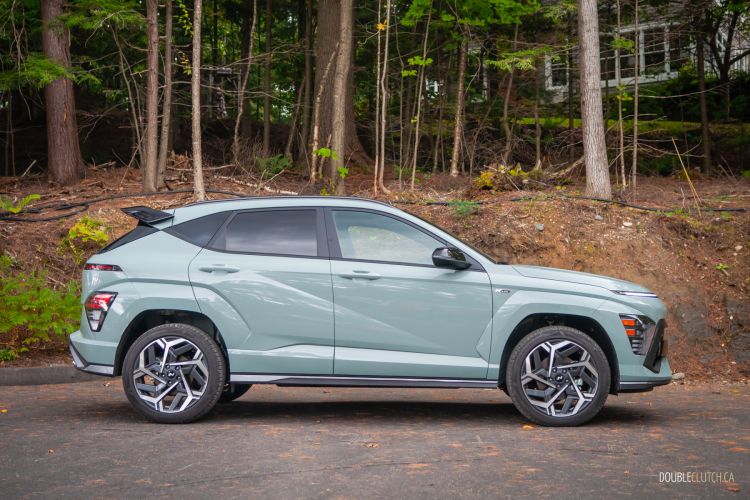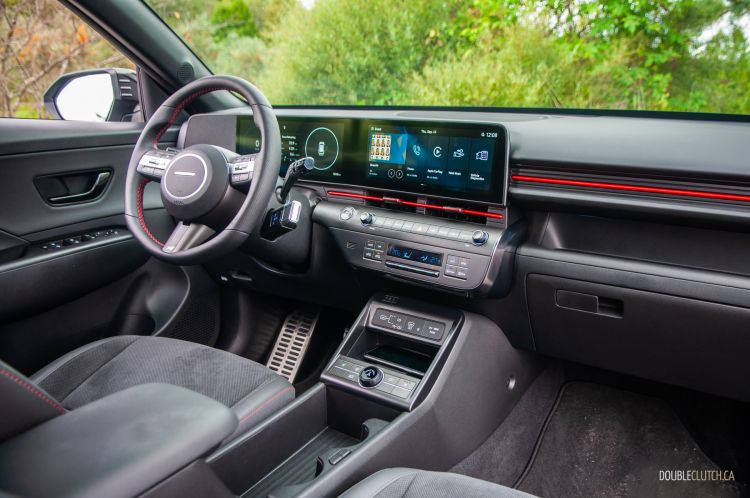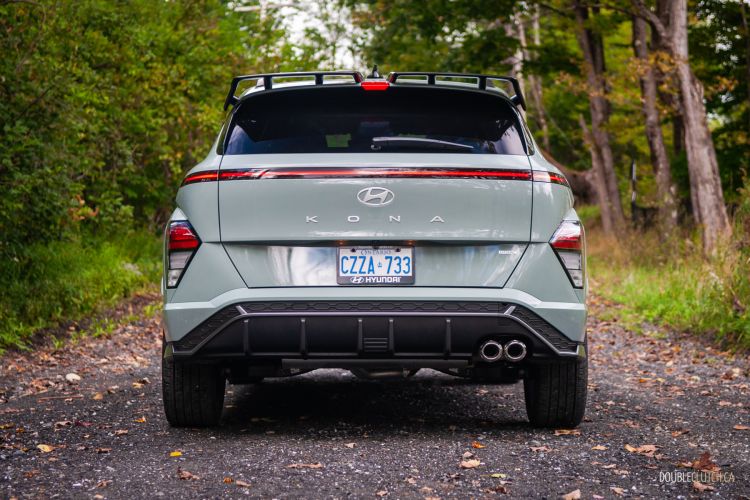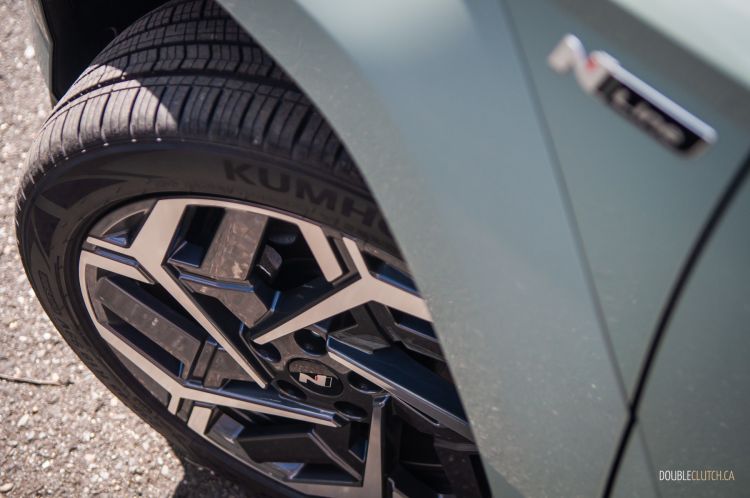AYER’S CLIFF, QUE. — While I probably shouldn’t tell you what “Kona” means in Portuguese, I can tell you what it means to us Canucks: the Kona is Hyundai’s entry into the fiercely competitive subcompact crossover market. So, it’s more than a little important that the 2024 Hyundai Kona gets its thorough redesign right. And get it right, it does.
The outgoing Kona was very much the right sport-ute at the right time. Having launched in 2018, just as the “subcompact” crossover segment began taking off, it took almost no time at all for the Kona to dominate sales charts. It blended diverse powertrain options, a boatload of bells and whistles, and excellent value into a funkily styled package. This second-generation glow-up maintains most of that, while also sprinkling in some much-needed improvements. The end result is a more mature, grown-up, and prettier Kona than before — even if it isn’t as strong of a value proposition it once was.

First, the big news. The 2024 Kona is longer, wider, and taller overall. It also has a longer wheelbase than before. This translates to a much more spacious interior, boasting 77 millimetres — a full three inches — of extra rear-seat legroom over the old Kona. You also get a smidge more front- and rear-seat headroom. Not only that, you also get more cargo space, at 723 litres with the seats down. The 2024 Kona isn’t quite class-leading size-wise, but it’s certainly on the roomy end of the segment, and much more practical than before.
In addition to the extra space, the second-gen Kona’s interior is just a nicer place to be. Although there are still quite a few hard touch-points, it no longer feels cheap; overall fit-and-finish is vastly improved. On upper trims, two 12.3-inch displays span across the dashboard, for the infotainment and instrument cluster. Both screens look crisp, and the infotainment is more responsive and even easier to use than before. Mercifully, Hyundai sticks with physical switchgear for the audio and climate controls. There’s even a radio-station tuning knob!

Interestingly, in developing the second-generation Kona, Hyundai cooked up the electric version first, before tackling the gas-powered variants. This results in a few clever quirks, mostly apparent on the N-Line and N-Line Ultimate trims. To wit: these two top-level trims share the same column-mounted shifter as the electric Kona, itself cribbed from the Ioniq 5 and 6 EVs. The functionality makes sense in theory — twist forward to drive, and back for reverse — but it took me more time than I care to admit before I got used to this. That said, it frees up a lot space on the centre console, allowing for a generously sized cubby and configurable cupholder arrangement similar to the Palisade.
In addition to the reworked interior, the 2024 Kona gets a new look, too. Even here, the subtle EV-ness is there; you wouldn’t be remiss for thinking even the gasser is electric. Up front, Hyundai swapped out the traditional grille for active air shutters. An LED light bar spans across the front end, and two pods of LED headlights and turn signals sit below. Along the side, the Kona wears more creases and folds, and from certain angles, it looks a bit like a Tucson Junior.

Out back, another LED light bar mimics the front, and N-Line models are finished off with an aggressive-looking rear diffusor and a hatch-mounted spoiler reminiscent of the Veloster N. Beauty is very much in the eye of the beholder; the 2024 Kona looks a tad busy, but it’s handsome overall and arguably better-looking than its predecessor.
And finally, focusing on the zappy version first means Hyundai sweated the details a lot more with ride quality. The Kona does a much better job at filtering out bumps, potholes, and other imperfections, even riding on 19-inch wheels. The cabin stays hushed at highway speeds, and road noise subtle background din at the most. As before, front-wheel-drive Konas use a torsion-beam rear suspension setup, but AWD models use a multi-link setup out back. It doesn’t make the Kona ride worse, that’s for sure!

The 2024 Kona’s gas powertrain options are familiar. Base models keep using a normally aspirated 2.0-litre four-cylinder engine, good for 147 horsepower and 132 pound-feet of torque. That’s paired to a continuously variable transmission, and all-wheel-drive is optional. If that’s not enough kick, the optional 1.6-litre turbo-four carries over into 2024 as well, putting out a punchy 190 hp and 195 lb-ft of torque. It’s now mated to a conventional eight-speed automatic transmission, like its cousin, the Kia Seltos. Healthy numbers and better than most of the competition for sure, but the Mazda CX-30 and its 250 horsepower — on 93-octane gas, mind you, whereas the Kona takes regular — remains the hot rod in the segment.
Still, the 1.6L turbo is well-matched to the Kona. It’s hardly a powerhouse, but it’s punchy and smooth, and the new automatic is much better-behaved than the seven-speed dual-clutch it replaces. Fuel economy is pretty good: on paper, Hyundai rates the 2024 Kona at 9.7 L/100 km in the city, 8.4 on the highway, and 9.1 combined. We covered a roughly 200-kilometre loop over mostly rural roads, and averaged a commendable 8.0 L/100 km.

So, here’s the thing. This new Kona is a pretty good sport-ute, but where it loses some of its appeal is pricing. A base, front-drive 2024 Kona starts at $25,999, while the N-Line sampled here runs you $35,499 before fees, taxes, and all that. To get all the bells-and-whistles — cooled and power-adjustable seats, a 360-degree camera, and Hyundai’s clever Blind View Monitor — you need to drop at least $38,499 for the range-topping N-Line Ultimate. Even then, it’s still missing key features like memory seats and wireless Apple CarPlay and Android Auto, which strangely enough, is available on lower trims.
The revamped Kona is one of those once-in-a-blue-moon automotive glow-ups that takes a good thing, and makes it even better. It may not be the nearly untouchable value proposition it once was, but the added space, polished road manners, and improved interior make the 2024 Hyundai Kona vastly more competitive. Sometimes, you really do get what you pay for.




















